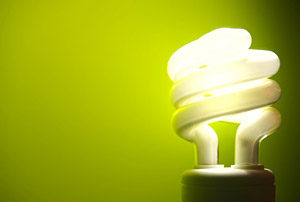Making up for lost daylight
Posted on 07 November 2008
The sun is setting
earlier in the northern hemisphere and for most Americans, clocks rolled back on November 2, stealing another hour of natural light.

Less time to both play
outdoors and work window-side means more time for electric powered lights.
This is no small matter. A
fourth of all electricity consumed in the United States goes toward lighting,
and 20 percent of that is spent air conditioning waste heat from inefficient
light bulbs. Plus, as my colleague
Cher Seruto notes, the more artificial light used at night, the less
stargazing for us all.
Lighting technologies
have come a long way since the incandescent bulb, which wastes more than 90
percent of its energy as heat. Here are a few lighting tips to make the extra
hour of dark in our evenings a moot point:
Smart Use First
Use lighting only
when and where you need it. Lighting a whole room so you can see what you’re
doing is similar to refrigerating a whole house to preserve perishable food.
Try using task lights instead. And if you can’t remember to turn off lights,
install occupancy sensors to do it for you when you enter or leave a room.
Efficient Lighting
Replace your halogen
torchieres! Ever wonder why they create fire hazards? These lamps operate at
970 degrees Fahrenheit. Compact
fluorescent (CFL) versions can save each year the carbon dioxide equivalent of
driving a medium-sized car 743 miles. You’ll also avoid $36 a year on your
electricity bills. For cost-saving details see Rocky Mountain Institute’s (RMI)
Home
Energy Brief #2 (PDF).
If you haven’t
switched out your incandescents for CFLs, don’t wait another minute. CFLs save
you money in two ways:
- They last
longer than incandescent bulbs (between 8500 hours and 11,250 hours depending
on how well you use them), and - They use less
electricity to provide the same amount of light — only 25 percent as much.
Specifically, each
CFL you install saves $50 in electricity costs over the lifetime of the bulb. If
you replaced five 75-watt bulbs with CFLs, you could save more than $250 over
eight years! See the American
Council for an Energy-Efficient Economy’s chart for details.
You could
accrue even more money by switching out incandescent fixtures for CFL fixtures.
If all households in the United States replaced five 100-watt fixtures with
23-watt CFL fixtures, enough electricity would be saved to power three cities
the size of New York day in and day out.
Want to do more? Try
purchasing some cutting-edge light emitting diodes (LEDs). These lights last
ten times longer than CFLs. Decorative LED lights — like those used to drape
across Christmas trees — use less than a dollar of electricity to operate over
the holiday season and large strings of light can save up to $75.
And when your lightbulbs do burn out, don’t
forget to recycle them. The Home Depot and IKEA collect CFLs. Check out the EPA
or Earth911.org to find your nearest
recycling location.
Adding Natural Light
Beyond electric lighting, plenty of
opportunities exist to add more sunlight. Daylighting lowers electricity use
and cooling loads, and enhances our visibility, health, and productivity. Try
these simple fixes:
- To reflect more light
around your rooms, paint a wall white and switch out darker carpeting for
lighter versions.
- Install a solar tube to funnel light into
spaces with few windows like dark hallways, bathrooms, and kitchens. These
fixtures are the low-cost alternative to skylights and are available for under
$400.
- Mount a lightshelf.
Lightshelves are flat surfaces attached to the exteriors of buildings that
bounce natural light through windows and deep into the building while also
reducing glare.
Designing from
scratch or embarking on major retrofits? See how RMI architects have
implemented their daylighting designs in homes, office
complexes, and factories.
For more information
check out RMI’s Home
Energy Brief #2 (PDF).
Maria Stamas is an analyst with Rocky
Mountain Institute.
No comments:
Post a Comment